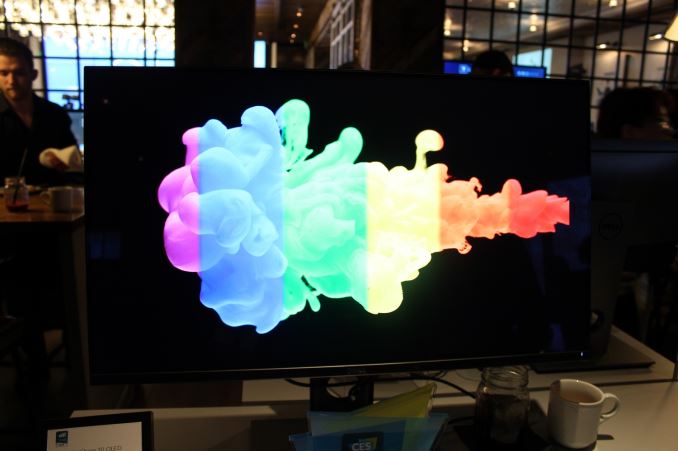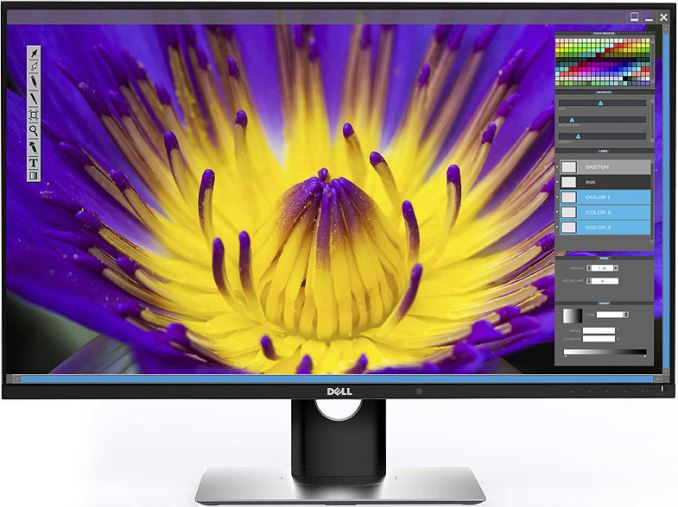Dell Demonstrates 30-inch 4K OLED Display
by Anton Shilov on January 7, 2016 6:40 PM EST- Posted in
- Monitors
- Dell
- Trade Shows
- 4K
- Ultrasharp
- CES 2016
- 30"
- OLED
- UP3017Q

Dell does not produce its own display panels, but when it comes to unique “world’s first” monitors, it is sometimes years ahead of all of its rivals. At the International CES 2016, Dell introduced its UltraSharp 30-inch OLED display, the company’s first monitor to use organic light emitting diode panel. The product is designed for professionals and carries a rather extreme price tag, but this is going to be a dream display for years to come.
The Dell UltraSharp UP3017Q is a 30-inch display with 3840×2160 resolution, 0.1 ms response time and an unknown refresh rate (yet, it should be very high). The monitor can reproduce 1.07 billion colors, it covers 100% of Adobe RGB color space as well as and 97.8% of DCI-P3 color space (used for digital movie projection by the U.S. movie industry and is expected to be adopted in televisions and in home cinema), according to Dell. Just a few professional displays nowadays cover 100% of Adobe RGB. The manufacturer declares 400,000:1 dynamic contrast ratio, but admits the value is only that because testing equipment won't go higher.
The UltraSharp UP3017Q ultra-high-definition display has very narrow bezels; the monitor itself is thin, but not remarkably thin like OLED TVs, possibly because it features internal power supply unit as well as complex logic inside. The monitor features a mini DisplayPort (mDP) connector, an HDMI port as well as a USB type-C port, which could be used for video and data connectivity as well as for power delivery (it can be powered using a type-C cable, or deliver power to another device).
Emissive electroluminescent layer in organic light-emitting diode is made of organic compound that emits light in response to an electric current. The organic semiconductor layer is situated between two electrodes and does not require a backlight. As a result, it can display truly deep black levels, unlike liquid crystal display (LCD) panels, which use various kinds of backlighting. Besides, since the emissive electroluminescent layer is very thin and can take different shapes, it is possible to build ultra-thin and even curved monitors and TVs using OLEDs.
While OLED technology can deliver deep blacks, high contrast ratio and exceptional colours, it is not free of drawbacks. The organic layer may burn down over prolonged amount of time, and colors can shift over time. To maximize lifespan of the OLED panel inside the UltraSharp UP3017Q, Dell integrated a special presence detector into the front panel of the display, which switches the monitor off when nobody uses it. Another disadvantage of OLEDs is a possibility of static image burn in. To reduce the chance of burn in, the UP3017Q has a special pixel-shifting technology.
The Dell UltraSharp 30 OLED monitor will cost whopping $4,999, which it becomes available on March 31, 2016, in the United States. The display at this point is only aimed at professionals, who work in color-critical environments such as graphic arts and photography. However, due to exceptional colors and contrast as well as ultra-fast response time, the UltraSharp UP3017Q will be a dream display for gamers, prosumers and other users, who value quality.
OLED panels are considerably more expensive to produce than modern LCD panels, partly because of lower yields. Last year an executive from LG Electronics said that yields of OLED panels had reached 80% and would continue to grow. At the International CES 2016, Kwon Bong-suk, the head of LG’s TV business, said that the company had cut prices of OLED TVs in the U.S. by 45% late in 2015. As a result, LG now expects sales of OLED televisions to triple this year. Price reduction of OLED TVs indicates that production costs of organic light-emitting diode panels are going down. Perhaps, over time, the Dell UltraSharp UP3017Q will also become more affordable, or Dell will release an OLED display for a wider audience.











83 Comments
View All Comments
twtech - Wednesday, September 5, 2018 - link
That's sort-of true. Working in Visual Studio, I actually use the mouse quite a bit. When just writing code, I might be able to live with 30 Hz - the blur on everything when scrolling, etc., wouldn't be great, but I could probably live with it if I had to.Fortunately I don't have to. My home setup has aged a bit - 3x Dell 30" Ultrasharp monitors, one of which was purchased in 2007, and the other two from 2011.
But I don't just code. I play games and do a variety of other things with my machine as well.
Zefeh - Friday, January 8, 2016 - link
You say it is stupid to upgrade but if your only complaint is thinking its a fad and gimick you really haven't looked into the details.The biggest improvement you can make in a display in increasing pixel density. It impacts many different aspects but the biggest is ideal viewing distance(ivd). Starting with current 1080p screens the recommended IVD of a 28" and 32" are 3.7 and 4.2 feet respectively. That is the distance where you get the best picture detail from the screen. With PC monitors, one sits MUCH closer than 4 feet from there 28" screen and because of that we notice all the pixels and imperfections of the 1080p display. Here's where 4k comes in.
The same size screen now has exactly double the pixel density. Viewing angles aside, your 28" monitor just went from 80 ppi to 160 ppi and the ideal viewing distance is much shorter as you can't see the detail unless your much closer. On some 4k monitors I've seen you need to squint about 2 inches away from the screen to see a pixel. On my current 24" 1080p monitor I can see a pixel from 2 feet away!
Why would the manufactures be making a mistake when they are progressing towards making the perfect display? Have you actually SEEN in person these displays? Anyone who's seen the curved 4k displays in bestbuy can see the difference. Get your eyes checked or venture out of the house to a Bestbuy because while you don't like it the world does. Why would you want a excact resolution like 1440 anyway? So randomly excact...
TL;DR - higher pixel density 4k screens = things look alot prettier alot closer than with a 1080p screen
wakrather - Tuesday, March 1, 2016 - link
I agree. if youre gaming on 1080p you are like gaming from 8 years ago, or have a TN film monitor that costs 150 dollars and looks terrible for colors. 1440p would have been the best thing in televisions as well. It could have been 240hz at 1440p in no time. 2x 1080 would be enormous visual jump and lots less cost and better quality.gochichi - Thursday, April 14, 2016 - link
You're being absurd. You say "if only they released this" "if only they released that" but clearly you don't buy anything. Any appealing modern laptop has a high density display, to dock it properly to an external monitor, the external monitor should be high density as well. There are $500 27" IPS 4k displays, (I'm using it right now, the P2715Q). I still have the 27" 1440P display that preceded it, has been flawless for years. You're waiting on what exactly? A 28"... not 27"... a 1440P not a 4K screen... and of course, the whole point: OLED. I'm with you on the OLED ($5K is more than I'll ever spend on a new display technology) I'm not wish you on the waiting. I'm happy to say I stopped wasting my own time on wishing for this or that exact spec, and instead started buying the closest thing that I like. I can honestly say that the P2715Q and P2415Q are incredible at their price points and there's never been more variety of really appealing monitors and at such incredible pricing. The 2011 27" 1440P dell is still the most expensive monitor Ive ever purchased and yet the 4K displays are handily, I mean handily much more amazing. It used to be that you had to wait... I'll "wait" for OLED too... but I'll do so with dual 4k screens that are already amazing. For right now, my favorite productivity setup for the buck is 2x 24" 4K P2415Q. Dual 27's is just too much. For home use, entertaintment or whatever, i'd go with one 24, or one 27. The world is 4k ready, and we're mere months away from full smooth gaming in 4k with just one $500 video card. And if you haven't bought a 4k monitor, or a $500 video card, or a high density laptop... why should any high end monitor cater to you? Makes no sense to me.Solandri - Friday, January 8, 2016 - link
We took a huge step back in color gamut when we switched to LCD monitors and TVs. Back in the cathode ray TV days, the color space was NTSC 1953, which is very similar to AdobeRGB. The current sRGB standard was created to accommodate the vastly inferior color reproduction of cheap LCD backlights.http://informationdisplay.org/portals/informationd...
So yeah, currently these bigger color spaces are only of interest to photo/video professionals. But eventually we'll move back to a bigger color gamut like NTSC or AdobeRGB for everything. If you've ever seen images on one of these wide-gamut screens, you can't wait for us to ditch sRGB. (No it doesn't mean colors will be oversaturated. That's just a side-effect of displaying sRGB images on an AdobeRGB monitor. When you display an AdobeRGB image on an AdobeRGB monitor, the colors are natural but can display much more vivid real-life hues that sRGB monitors can't display.)
bigboxes - Wednesday, March 9, 2016 - link
I bought one of the last generation Panasonic plasma televisions. It will do until OLED costs come down. I waited a long time to jump into 1080p. I think I should be fine until 4K media is readily available. Now, monitors are a different thing. I will seriously consider a 32" OLED monitor if the costs near $2k.NEDM64 - Thursday, January 7, 2016 - link
This is not for gamersImSpartacus - Thursday, January 7, 2016 - link
I think that's the issue that he's pointing out.It feels like an OLED-based monitor would make a mean VRR display.
Byte - Friday, January 8, 2016 - link
240hz please.DanNeely - Friday, January 8, 2016 - link
240Hz would need 2 cables even with the upcoming DP1.3 standard. With DP1.2 or HDMI2 (barely available now), you'd need 4 cables. Either that or the "minimally lossy" compression standard that is being discussed as a way to fit 8k video signals down a single cable at a price that normal consumers would be willing to pay.